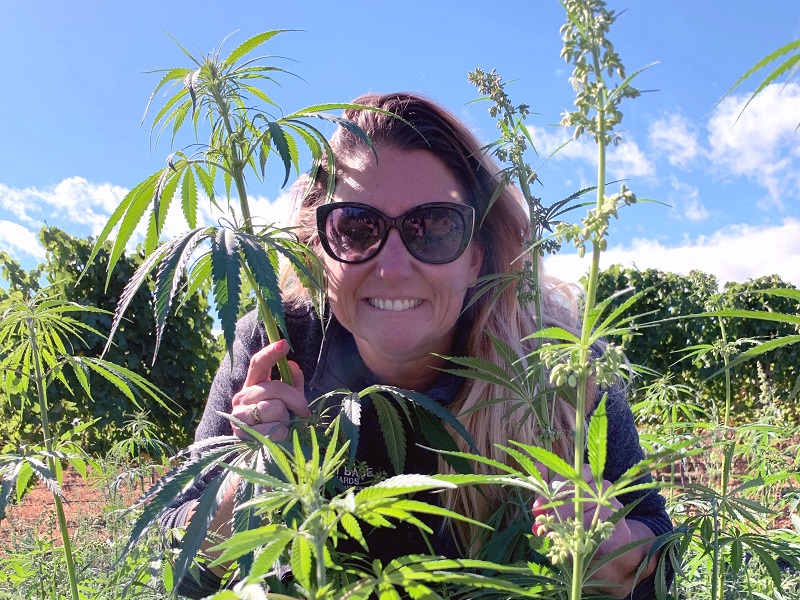By Eleanor Danenberg
Industrial hemp plants are part of what is believed to be a world-first trial to investigate if the plant can provide positive input to a vineyard. The trial, taking place in Marlborough, New Zealand, is the brainchild of Kirsty Harkness, managing director and co-owner of Marlborough’s Mount Base Vineyards. Harkness is almost one year into a four-year trial.
“I thought it was a good idea to trial a cover crop that we could potentially earn a second income from without disadvantaging the vines,” Harkness says. “There are other benefits to the vineyard and environment we are discovering too. Due to our grapes already being a high value crop, we are doing trials to assess the impacts on vine growth, nutrition, and productivity of planting hemp in the interrow.”
Last year Harkness obtained a license from the NZ Ministry of Health to grow industrial hemp, and she began planting in January this year. She notes December would be the ideal time to plant, with one of the aims of her trials to determine the optimum planting time for hemp to maximise both hemp seed production and vine yield. For 2019, Harkness is planting a further 130 acres of the Kompolti hemp strain across three Sauvignon Blanc vineyards around Marlborough. She is growing the hemp down the rows as a cover crop and is trialling planting at different densities.
At the different sites Harkness has tested how the plants respond to different levels of irrigation while growing. One area received an initial water, one received no water at all, and one was watered weekly for six weeks, with that crop turning out the best. Harkness says unfortunately in this growing period, there was only 10mm of rain in 75 days, but it was useful to see how the plants dealt with dry weather.
How tall the plants grow depend on sunlight hours, Harkness says.
“The plants we grew outside the rows grew up to two metres, but the ones down the interrow that have sunlight hours competition with canopy (getting only two hours of sun a day later in the season) only grew to 30-60 cm,” Harkness says. “Somewhere between 60-90cm would be optimum, with good seed heads.”
Harkness has also found hemp plants attract insect life that has been beneficial to the vines so far, adding sticky traps have been put out this year to examine this factor further.
“The bees also went crazy for the pollen,” she adds.
There are 14 different cultivars of industrial hemp that are legal to grow with a licence in New Zealand, and they all have different attributes, including different heights. Harkness initially planted Kompolti as it was the only strain available to her when she started out, but she is trialing other cultivars this year that she believes may be more optimal in the vineyards.
Another beneficial aspect of growing industrial hemp in the vineyard, Harkness says, has been the mulch made from the hemp plants; she has found weeds don’t grow through it initially, it doesn’t blow away like straw, it holds four times its body weight in water, and it insulates the ground. Her organic matter soil samples have been positive in their first year. She is also trialling crimp rolling this year instead of mulching.
Harkness confirms the hemp has presented no problems in the vineyard so far, saying it has been “all positive”, and “better than we had hoped”. However, she has chosen to do this trial over four years to ensure long term consistency with the results and that there are no negative effects on vines.
As part of the trial, Dr Mark Krasnow from Thoughtful Viticulture will undertake research on how the hemp impacts vines’ nutrient and water uptake, how it affects vine health, what the mulch provides to soil properties, as well as looking into whether hemp affects wine flavours and aromas. From what Krasnow has been able to ascertain from his university colleagues in UC Davis in California, and Oregon, “this is the first scientifically replicated study on the use of hemp as a cover crop in vineyards, which is pretty exciting to be a part of”.
Krasnow’s aim is to publish his and Harkness’ findings in a grower-friendly format each year beginning in 2020.
“We have had more interest and support than I imagined,” Harkness says of the industry’s response to her trials. She has made a Facebook page, ‘VinHemp – Vineyard Hemp Cover Crops NZ’, where those interested can keep up to date with her findings.
This article was first published in the November 2019 issue of the Australian & New Zealand Grapegrower & Winemaker. To subscribe from as little AUD$55 a year for 12 issues click here
















